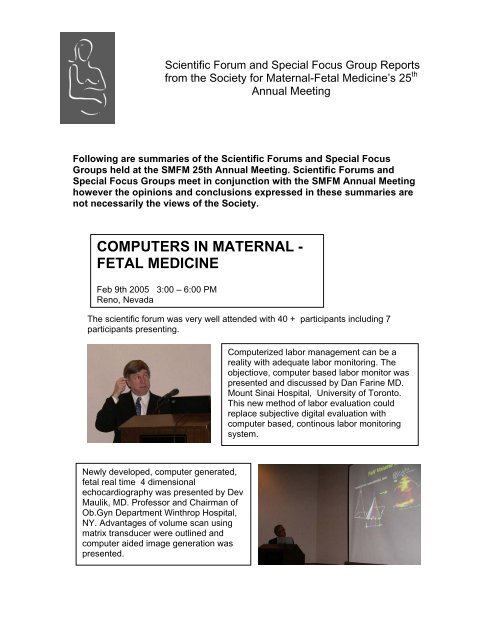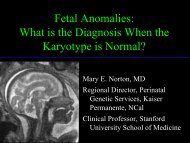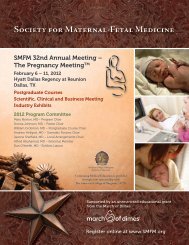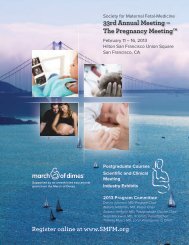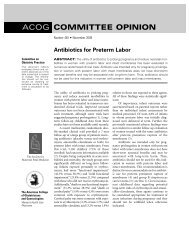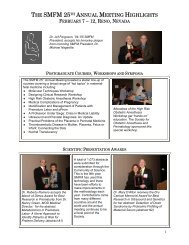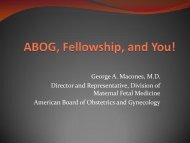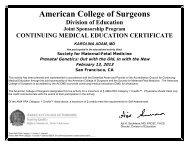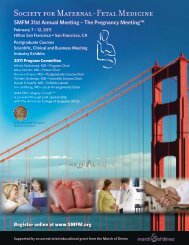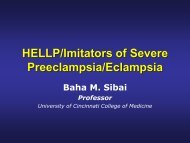Agenda for Computers in Perinatal Medicine meeting 2002
Agenda for Computers in Perinatal Medicine meeting 2002
Agenda for Computers in Perinatal Medicine meeting 2002
You also want an ePaper? Increase the reach of your titles
YUMPU automatically turns print PDFs into web optimized ePapers that Google loves.
Scientific Forum and Special Focus Group Reports<br />
from the Society <strong>for</strong> Maternal-Fetal Medic<strong>in</strong>e’s 25 th<br />
Annual Meet<strong>in</strong>g<br />
Follow<strong>in</strong>g are summaries of the Scientific Forums and Special Focus<br />
Groups held at the SMFM 25th Annual Meet<strong>in</strong>g. Scientific Forums and<br />
Special Focus Groups meet <strong>in</strong> conjunction with the SMFM Annual Meet<strong>in</strong>g<br />
however the op<strong>in</strong>ions and conclusions expressed <strong>in</strong> these summaries are<br />
not necessarily the views of the Society.<br />
COMPUTERS IN MATERNAL -<br />
FETAL MEDICINE<br />
Feb 9th 2005 3:00 – 6:00 PM<br />
Reno, Nevada<br />
The scientific <strong>for</strong>um was very well attended with 40 + participants <strong>in</strong>clud<strong>in</strong>g 7<br />
participants present<strong>in</strong>g.<br />
Computerized labor management can be a<br />
reality with adequate labor monitor<strong>in</strong>g. The<br />
objectiove, computer based labor monitor was<br />
presented and discussed by Dan Far<strong>in</strong>e MD.<br />
Mount S<strong>in</strong>ai Hospital, University of Toronto.<br />
This new method of labor evaluation could<br />
replace subjective digital evaluation with<br />
computer based, cont<strong>in</strong>ous labor monitor<strong>in</strong>g<br />
system.<br />
Newly developed, computer generated,<br />
fetal real time 4 dimensional<br />
echocardiography was presented by Dev<br />
Maulik, MD. Professor and Chairman of<br />
Ob.Gyn Department W<strong>in</strong>throp Hospital,<br />
NY. Advantages of volume scan us<strong>in</strong>g<br />
matrix transducer were outl<strong>in</strong>ed and<br />
computer aided image generation was<br />
presented.
Dr Shraga Rottem from Ironfan<br />
Institute, Columbia Univ, NY Center<br />
presented AI based early pregnancy<br />
diagnostic algorhytm to detect fetal<br />
abnormalities by sonography. AI <strong>for</strong><br />
First Trimester Genetic Mapp<strong>in</strong>g by<br />
Ultrasound is designed to help<br />
physician correctly diagnose fetal<br />
abnormalities.<br />
Computer assisted simulation of<br />
emergency conditions <strong>in</strong> labor room was<br />
presented by group of Dr Ariel Many, MD<br />
Lis Hospital, Tel Aviv, Israel.<br />
Specific obstetrical situations can be<br />
dealt with more effectively if studied <strong>in</strong><br />
simulation enviroment.<br />
Integration of Research and Cl<strong>in</strong>ical In<strong>for</strong>mation<br />
Systems <strong>in</strong> OB/GYN was presented by Dr Sean<br />
Blackwell from Wayne State Univ, MI. His<br />
group has developed computer system<br />
designed <strong>for</strong> the needs of the active Ob/Gyn<br />
department. Image management, patient’s<br />
documentation, medical research and other data<br />
are <strong>in</strong>tegrated <strong>in</strong> one system.<br />
In<strong>for</strong>matics and Beyond, was a topic of the<br />
presentation of Dr Emily Hamilton, from<br />
McGill Univ. QE, Canada. Dr Hamilton has<br />
developed computer system that can<br />
monitor and help <strong>in</strong> mak<strong>in</strong>g correct<br />
decisions <strong>in</strong> manag<strong>in</strong>g obstetrical<br />
situationsmore efficiently.
Intelligent patient’s record; from data to<br />
<strong>in</strong><strong>for</strong>mation. Experience with implementation of<br />
electronic medical recordsb that monitors cl<strong>in</strong>ical<br />
decisions was presented by Shoshana<br />
Haberman, MD, Maimonides medical Center,<br />
NY. Dr Haberman experience was significant <strong>in</strong><br />
be<strong>in</strong>g consistently <strong>in</strong> use <strong>for</strong> several years with<br />
measurable improvements <strong>in</strong> obstetrical care.<br />
Experience with Development of Prenatal<br />
Electronic Medical Records was presented<br />
by Bruce Chen, MD from Tripler Med Center,<br />
HI. In his presentation Dr Chen has<br />
reviewed difficulty and limitations <strong>in</strong><br />
develop<strong>in</strong>g electronic medical records even<br />
if <strong>in</strong>stitutional support is available. His<br />
experience is <strong>in</strong>valuable to anyone plann<strong>in</strong>g<br />
on develop<strong>in</strong>g such a records<br />
Andrzej Lysikiewicz, MD, PhD. W<strong>in</strong>throp<br />
Hospital, SUNY, Nypresented Computer<br />
assisted 3 D fetal biometry, VOCAL (virtual<br />
organ calculation analysis). This<br />
technique allows <strong>for</strong><br />
volumemeasurementsof fetal organs<br />
recreated <strong>in</strong> computer model.<br />
Members <strong>in</strong>terested <strong>in</strong> active participation <strong>in</strong> future meet<strong>in</strong>gs are <strong>in</strong>vited to contact Dr<br />
Andrzej Lysikiewicz or Dr Sean Blackwell with any suggestions or plans <strong>for</strong> the future<br />
meet<strong>in</strong>gs.<br />
Special Interest Group - <strong>Computers</strong> <strong>in</strong> Maternal Fetal Medic<strong>in</strong>e<br />
A. Lysikiewicz MD,<br />
Director, Per<strong>in</strong>atal Ultrasound.<br />
W<strong>in</strong>throp Hospital, M<strong>in</strong>eola, NY<br />
120 M<strong>in</strong>eola Blvd Suite 110, N.Y, N.Y.11501<br />
Tel - 516 663 3020.<br />
Alyss@msn.com
Critical Care Summary<br />
Leader: Stephanie Mart<strong>in</strong>, MD<br />
Once aga<strong>in</strong>, several <strong>in</strong>terest<strong>in</strong>g cases were presented <strong>for</strong> a lively and <strong>in</strong>terest<strong>in</strong>g<br />
discussion. Walter Harry, a maternal-fetal medic<strong>in</strong>e fellow from the University of<br />
Arizona, and Stephanie Mart<strong>in</strong>, a per<strong>in</strong>atologist from Phoenix, AZ, highlighted the<br />
importance of advance plann<strong>in</strong>g and preventive therapy to m<strong>in</strong>imize the need <strong>for</strong> blood<br />
products <strong>in</strong> patients at high risk <strong>for</strong> hemorrhage. Options presented <strong>in</strong>cluded antepartum<br />
IV Iron supplementation, erythropoiet<strong>in</strong>, acute normovolemic hemodilution, autologous<br />
blood donation, and use of the cell saver technology.<br />
Leah Battista, a Maternal-fetal medic<strong>in</strong>e fellow at the University of Cali<strong>for</strong>nia, Irv<strong>in</strong>e,<br />
presented an unusual patient with a large pancreatic pseudocyst dur<strong>in</strong>g pregnancy. While<br />
many <strong>in</strong> the audience expressed temptation to surgically excise the cyst due to its size and<br />
presentation, Dr. Battista presentation of the literature supported the conservative<br />
approach adopted by the patient's medical team. This patient educated us all!<br />
Connie Graves, a per<strong>in</strong>atologist at Vanderbilt University <strong>in</strong> Nashville, TN, and resident<br />
Patricia Scott, MD impressed the audience with their astute and timely diagnosis of<br />
herpetic hepatitis and encephalitis. This patient certa<strong>in</strong>ly benefited from Dr. Graves'<br />
prior experience with a similar patient and those <strong>in</strong> the audience have a new appreciation<br />
<strong>for</strong> the manifestations and diagnosis of herpetic hepatitis.<br />
We are look<strong>in</strong>g <strong>for</strong>ward to more <strong>in</strong>terest<strong>in</strong>g cases next year!<br />
Stephanie Mart<strong>in</strong>
2005 Genetics Special Interest Group<br />
Leader – George P. Henry, MD<br />
This year focused on implementation of First Trimester Risk Estimation.<br />
S<strong>in</strong>ce I was one of the speakers Jack Larson was moderator this year.<br />
Sherman Elias was a late addition to speak about progress on a<br />
comb<strong>in</strong>ed MFM and Genetics fellowship which should satisfy both boards.<br />
David Krantz spoke about the largest private data base us<strong>in</strong>g nuchal<br />
translucency, free BHCG, and PAPP-A; Demonstrat<strong>in</strong>g that it can be and is<br />
implemented <strong>in</strong> the USA, with certification.<br />
Mary Dalton had been a featured speaker dur<strong>in</strong>g preparations <strong>for</strong> the<br />
Faster Trial and she spoke this year on SMFM plans <strong>for</strong> NT Certification. The<br />
entire program is available on the SMFM web site. The first question was when<br />
the society would get to vote on this program. The answer was that the<br />
program is already set up.<br />
Jon Hyett, from London, reviewed the practicalities, pr<strong>in</strong>ciples, and<br />
experience of the Fetal Medic<strong>in</strong>e Foundation program.<br />
Mark Evans reviewed multiple data sets and reviewed how new<br />
technologies move from experimental to available without <strong>in</strong>surance<br />
reimbursement to rout<strong>in</strong>e with <strong>in</strong>surance reimbursement.<br />
The contradictory premise by George Henry was that First Trimester<br />
Risk Estimation is NOT cost effective <strong>for</strong> advanced maternal age patients, <strong>in</strong><br />
this country, compared to rout<strong>in</strong>e amniocentesis <strong>for</strong> AMA. The first blush would<br />
lead one to th<strong>in</strong>k that screen<strong>in</strong>g AMA patients and do<strong>in</strong>g CVS on the 10%<br />
screen positive would save money over amniocentesis <strong>for</strong> all AMA patients. But<br />
with 80% detection of Down syndrome one must <strong>in</strong>clude the $1 million each<br />
lifetime cost <strong>for</strong> cases which would not have been missed by amniocentesis.<br />
Because CVS has a 1% pregnancy loss rate vs. 1/1100 <strong>for</strong> amniocentesis<br />
screen<strong>in</strong>g results <strong>in</strong> more pregnancy losses. Amnios reveal ALL aneuploidy<br />
while risk estimation misses 20% of Trisomy, 20% of Trisomy 18, and more sex<br />
chromosome aneuploidy. Risk estimation is appropriate <strong>for</strong> low risk populations<br />
to identify patients who could benefit from diagnostic test<strong>in</strong>g.<br />
Apply<strong>in</strong>g risk estimation to AMA patients:<br />
1. Does not save money<br />
2. Does not save pregnancies<br />
3. Does do harm by falsely reassur<strong>in</strong>g perhaps half of aneuploid pregnancies<br />
Even 80% detection of Trisomy 21 is not good enough when we have a<br />
very safe 100% accurate diagnostic test by amniocentesis. Risk estimation if<br />
not diagnostic and is not a substitute <strong>for</strong> diagnostic test<strong>in</strong>g by amniocentesis.<br />
This yearly report is adjusted to <strong>in</strong>clude the 2004 report which was<br />
withheld by SMFM. It was submitted on time and after much argument it was<br />
f<strong>in</strong>ally posted 2 months later when you had no likelihood of stumbl<strong>in</strong>g upon it.<br />
You may decide <strong>for</strong> yourself why SMFM may not have wanted you to see it.
Genetics Special Interest Group<br />
2004<br />
At the genetics special <strong>in</strong>terest group, Shama Jari reviewed Smith-Lemli-<br />
Opitz Syndrome with prenatal onset of growth deficiency as a result of a<br />
metabolic defect which impedes production of cholesterol. SLO will become a<br />
part of the differential diagnosis <strong>in</strong> cases of IUGR especially with a low serum<br />
estriol.<br />
Louise Wilk<strong>in</strong>s reviewed the history and data regard<strong>in</strong>g the possible<br />
<strong>in</strong>creased risk of genetic impr<strong>in</strong>t<strong>in</strong>g errors as a result of IVF, ICSI, embryo<br />
manipulation and culture. There is now a registry at her center <strong>for</strong> Beckwith-<br />
Wiedemann syndrome cases associated with IVF pregnancies.<br />
The bulk of the program revolved around genetic screen<strong>in</strong>g- both first<br />
and second trimester as <strong>in</strong> the FASTER TRIAL (first and second trimester<br />
evaluation of risk). In our session it was clear from the SMFM abstracts and<br />
prelim<strong>in</strong>ary lectures be<strong>in</strong>g given by FASTER TRIAL authors that their results<br />
would not replicate the experience of other groups- some of which have a larger<br />
experience than the FASTER authors.<br />
Jon Hyett reviewed first trimester screen<strong>in</strong>g by biochemistry (free beta<br />
HCG plus PAPP-A) and ultrasound <strong>for</strong> nuchal translucency. It is clear that<br />
meticulous tra<strong>in</strong><strong>in</strong>g and cont<strong>in</strong>ued oversight is <strong>in</strong>tegral to success of such a<br />
program. He also reviewed the variations of us<strong>in</strong>g first trimester followed by<br />
second trimester screen<strong>in</strong>g (sequential) or of <strong>in</strong>tegrated screen<strong>in</strong>g where<br />
biochemistry and ultrasound data from both first and second trimester are<br />
obta<strong>in</strong>ed and comb<strong>in</strong>ed be<strong>for</strong>e mak<strong>in</strong>g an assessment of risk. Only then is the<br />
option of the def<strong>in</strong>itive diagnostic test offered to the patient.<br />
The latter is the FASTER TRIAL model. The published computer model<br />
by Nick Wald (SURUSS study) projects 85% detection of Down syndrome <strong>for</strong> a<br />
1.3% screen positive rate. While this sounds as good as you could possibly get<br />
it requires withhold<strong>in</strong>g the first trimester biochemical and ultrasound f<strong>in</strong>d<strong>in</strong>gs<br />
from the patient. That would not be acceptable or legal <strong>in</strong> this country.<br />
Professor Wald has acknowledged at the American College Medical Genetics
meet<strong>in</strong>g that he holds a patent on the computer model<strong>in</strong>g system <strong>for</strong> <strong>in</strong>tegrated<br />
screen<strong>in</strong>g.<br />
Jon Hyett reports about 80% Down syndrome detection by first trimester<br />
screen<strong>in</strong>g <strong>for</strong> a 5% rate of diagnostic CVS or amniocentesis. The FASTER<br />
TRIAL ascerta<strong>in</strong>ed only about 60% by first trimester screen<strong>in</strong>g. In their trial they<br />
excluded “cystic hygromas” as a different f<strong>in</strong>d<strong>in</strong>g than <strong>in</strong>creased nuchal<br />
translucency. This removed twenty-six Down syndrome cases which were, <strong>in</strong><br />
fact, seen to be abnormal, i.e. detected, on first trimester ultrasound. Includ<strong>in</strong>g<br />
those cases would have brought them close to the British and other USA<br />
experiences.<br />
When first trimester screen<strong>in</strong>g is be<strong>in</strong>g used most cases of Down<br />
syndrome are detected (whether you accept 60% or 80%). The problem with<br />
then add<strong>in</strong>g a second trimester screen<strong>in</strong>g (biochemical and ultrasound) is that 3<br />
of 5 or 4 of 5 cases of Down Syndrome are already absent so the cost benefit of<br />
second trimester screen<strong>in</strong>g is severely degraded and may not be relevant to do.<br />
In the US, us<strong>in</strong>g second trimester screen<strong>in</strong>g alone, we have about 80%<br />
detection of Down syndrome <strong>for</strong> a 5% amniocentesis rate.<br />
Simona Cicero reviewed the data on presence/absence of nasal bone as<br />
a marker <strong>for</strong> risk of Down Syndrome. Add<strong>in</strong>g nasal bone to first trimester<br />
screen<strong>in</strong>g br<strong>in</strong>gs Down Syndrome Detection to above 90% by first trimester<br />
screen<strong>in</strong>g. She emphasized aga<strong>in</strong> how critical teach<strong>in</strong>g and meticulous<br />
technique is to success with nasal bone visualization. Nasal bone was not a<br />
consideration at <strong>in</strong>itiation of the the FASTER TRIAL. It was added to the first<br />
trimester scans partway through with a limited attempt to tell (but not teach)<br />
people how to do it. None of the 9 Down Syndrome cases exam<strong>in</strong>ed <strong>for</strong> nasal<br />
bone were thought to have absent nasal bone on ultrasound. The FASTER<br />
authors conclude that nasal bone is not effective. This simply proves aga<strong>in</strong> that<br />
if you do not know how to do a test it will not work well. It reportedly works well,<br />
with proper tra<strong>in</strong><strong>in</strong>g and quality control, <strong>in</strong> England, the US, and <strong>in</strong>ternationally.<br />
There is already a large data base <strong>in</strong> the US us<strong>in</strong>g biochemistry and<br />
ultrasound <strong>for</strong> nuchal translucency. It has been modeled on the U.K.<br />
experience with thorough teach<strong>in</strong>g and certification of proper nuchal<br />
translucency measurement. That database which is larger than the FASTER
TRIAL per<strong>for</strong>ms well with 90% detection of Down syndrome <strong>for</strong> a 5% screen<br />
positive rate.<br />
The session concluded with a summation and geneticist’s perspective.<br />
The FASTER TRIAL was a huge federal f<strong>in</strong>ancial commitment to attempt to<br />
duplicate the British experience <strong>in</strong> the U.S. It will no doubt be published as a<br />
lead article <strong>in</strong> a prestigious journal. It may take a while to be seen as a disaster<br />
where a number of academic centers, armed with $13.5 million of federal funds,<br />
couldn’t do screen<strong>in</strong>g as well as our European colleagues accomplished with<br />
nearly no visible support.<br />
Because <strong>in</strong>tegrated screen<strong>in</strong>g requires withhold<strong>in</strong>g first trimester f<strong>in</strong>d<strong>in</strong>gs<br />
from the patient it would be wrong <strong>for</strong> the SMFM to attempt to implement a U.S.<br />
program modeled after the FASTER TRIAL.<br />
One must back up and look at the big picture of chromosome<br />
abnormalities. The above screen<strong>in</strong>g focuses on Trisomy 21 and most Trisomy<br />
18, but this is not even half of the chromosome abnormalities which happen to<br />
families. Chromosome abnormalities are devastat<strong>in</strong>g to families emotionally<br />
and f<strong>in</strong>ancially. Down syndrome is a prom<strong>in</strong>ent focus with the costs of 100%<br />
mental retardation requir<strong>in</strong>g lifelong assisted liv<strong>in</strong>g plus a 40% <strong>in</strong>cidence of<br />
congenital heart disease. Other chromosome abnormalities also have serious<br />
consequences even threaten<strong>in</strong>g the <strong>in</strong>tact cont<strong>in</strong>uity of families. Down<br />
Syndrome is not the only problem. The other th<strong>in</strong>g to note is that all screen<strong>in</strong>g<br />
discussions <strong>in</strong>volve maximiz<strong>in</strong>g detection while m<strong>in</strong>imiz<strong>in</strong>g <strong>in</strong>vasive diagnostic<br />
test<strong>in</strong>g on the assumption that amniocentesis is dangerous and to be avoided.<br />
But amniocentesis is DIAGNOSTIC.<br />
The most important abstract from the FASTER TRIAL shows the risk of<br />
pregnancy loss from amniocentesis is 0.15%- far less than the 0.5% risk long<br />
quoted by pessimists <strong>in</strong> any discussion of avoid<strong>in</strong>g amniocentesis. There is<br />
now published data (Lancet Jan. 24, 2004) that amniocentesis is cost effective<br />
at any age or risk level. That study preceded the FASTER abstract - so<br />
amniocentesis is, <strong>in</strong> fact, far more cost effective at any age or risk level.<br />
The diverse approaches to screen<strong>in</strong>g appear to be superb <strong>for</strong><br />
identification of <strong>in</strong>creased risk <strong>in</strong> patients who were not already known to be at<br />
risk but may not be as appropriate <strong>for</strong> “risk reduction” by biochemistry or<br />
ultrasound <strong>in</strong> women already known to have an <strong>in</strong>dication <strong>for</strong> amniocentesis.
The fallacy of cytogenetics by ultrasound was explored <strong>in</strong> prior years’<br />
sessions. Screen<strong>in</strong>g is a great application <strong>for</strong> low risk populations to identify<br />
cases need<strong>in</strong>g the option of further test<strong>in</strong>g. If couples wish to avoid “the needle”<br />
by us<strong>in</strong>g screen<strong>in</strong>g as their decision maker they should understand that after<br />
amniocentesis they have no risk of a diagnosable chromosome abnormality <strong>in</strong><br />
their newborn. If their screen<strong>in</strong>g test gives them a statistically decreased risk, it<br />
is their prerogative (or their government health care plan) to decl<strong>in</strong>e diagnostic<br />
test<strong>in</strong>g. That leaves them with a persistent chance of an abnormal outcome-at<br />
least half of what it was a priori- which cannot be predicted or prevented by<br />
presently available screen<strong>in</strong>g tests.<br />
The only way to know that a fetus has normal chromosomes is to<br />
exam<strong>in</strong>e the chromosomes. Patients may select that <strong>in</strong>stead of screen<strong>in</strong>g. In<br />
order to decrease human suffer<strong>in</strong>g as well as on a f<strong>in</strong>ancial basis amniocentesis<br />
should be <strong>in</strong>creas<strong>in</strong>g and not discouraged <strong>in</strong> the process of screen<strong>in</strong>g.<br />
Screen<strong>in</strong>g <strong>for</strong> previously unknown risk plus more liberal use of diagnostic<br />
test<strong>in</strong>g will become the norm.<br />
George P. Henry, MD
2005 SMFM Meet<strong>in</strong>g<br />
Maternal-Fetal Surgery Scientific Forum<br />
Once aga<strong>in</strong>, the Maternal-Fetal Surgery Scientific Forum presented to a stand<strong>in</strong>g-room-only audience at<br />
the Annual Meet<strong>in</strong>g of the SMFM. The Forum began with a summary by Mary D’Alton, M.D., New York,<br />
NY, of a fetal therapy workshop conducted at the NICHD <strong>in</strong> 2004. One of the major outcomes of the<br />
NICHD workshop was a consensus that an umbrella organization to foster collaboration <strong>in</strong> the conduct of<br />
quality research and cl<strong>in</strong>ical services dur<strong>in</strong>g the diagnosis and treatment of fetal anomalies is needed.<br />
Workshop participants agreed that such a group should be <strong>in</strong>clusive and broad-based with fund<strong>in</strong>g<br />
capabilities. Several models of collaborative organizations were discussed.<br />
Cather<strong>in</strong>e Shaer, M.D., Bethesda, Maryland, provided an update of the ongo<strong>in</strong>g MOMS Trial<br />
(Management of Myelomen<strong>in</strong>gocele Study), the NICHD-sponsored randomized trial of prenatal versus<br />
postnatal closure of myelomen<strong>in</strong>gocele. As of January 2005, 64 patients have been randomized. The<br />
12-month follow up exam<strong>in</strong>ations have begun. Participat<strong>in</strong>g cl<strong>in</strong>ical centers are Vanderbilt University<br />
Medical Center, CHOP, and UCSF. Candidates can obta<strong>in</strong> useful <strong>in</strong><strong>for</strong>mation at<br />
www.sp<strong>in</strong>abifidamoms.com or by call<strong>in</strong>g 1-866-ASK-MOMS.<br />
Louise Wilk<strong>in</strong>s-Haug, M.D., Boston, MA, presented outcome data of balloon dilation of severe aortic<br />
stenosis <strong>in</strong> X fetuses <strong>in</strong> the second trimester of pregnancy. The m<strong>in</strong>imally <strong>in</strong>vasive procedure was<br />
technically successful <strong>in</strong> 22/29 subjects with a median gestational age of 24 weeks. In liveborn <strong>in</strong>fants<br />
follow<strong>in</strong>g technically successful aortic valve dilation <strong>in</strong> utero, 6/20 (30%) have biventricular circulation.<br />
Further <strong>in</strong><strong>for</strong>mation can be obta<strong>in</strong>ed by call<strong>in</strong>g 617-355-8967/7893.<br />
Jan Deprest, M.D., Leuven, Belgium, presented <strong>in</strong><strong>for</strong>mation about the European pilot study of congenital<br />
diaphragmatic hernia (CDH) treatment <strong>in</strong> utero. Offered only to patients with severe disease with a low<br />
likelihood of survival, therapy <strong>in</strong>volves balloon occlusion of the trachea via a m<strong>in</strong>imally <strong>in</strong>vasive approach<br />
<strong>in</strong> the second trimester of pregnancy. Further ref<strong>in</strong>ements <strong>in</strong>clude removal of the balloon after optimal<br />
lung growth is documented, mak<strong>in</strong>g an EXIT procedure unnecessary. Prelim<strong>in</strong>ary results have been<br />
promis<strong>in</strong>g and a randomized trial is anticipated. Michael Harrison, M.D., San Francisco, CA, widely<br />
recognized as the father of fetal surgery, discussed his 25 years of experience <strong>in</strong> the treatment of this<br />
serious congenital anomaly. He applauded the ref<strong>in</strong>ements <strong>in</strong> the procedure <strong>in</strong>troduced by the European<br />
research group, and po<strong>in</strong>ted out that the last U.S. trial began almost six years ago. Based on the<br />
consistently encourag<strong>in</strong>g outcomes reported <strong>in</strong> the European study, a new trial <strong>in</strong> the United States may<br />
soon be anticipated.<br />
Joseph Bruner, M.D., Nashville, Tennessee, presented an update on the pilot study of amnioexchange <strong>for</strong><br />
gastroschisis at Vanderbilt. A multicenter randomized controlled trial is planned and expected to beg<strong>in</strong><br />
this year.<br />
Douglas Wilson, M.D., Philadelphia, PA, described the CHOP experience <strong>in</strong> the treatment of lower ur<strong>in</strong>ary<br />
tract obstructions (LUTO). Evaluation and therapy us<strong>in</strong>g vesicoamniotic shunt<strong>in</strong>g and/or cystoscopy are<br />
offered. In the last four years, 76 patients were evaluated and 36 were found to be suitable candidates<br />
<strong>for</strong> therapy. Twenty fetuses received shunts, and four underwent cystoscopic evaluation and treatment.<br />
Wilson emphasized that to date, no randomized trials of LUTO therapy <strong>in</strong> utero have been conducted.<br />
Interested parties can be referred to 1-800-IN-UTERO at CHOP.<br />
Ruben Qu<strong>in</strong>tero, M.D., Tampa, FL, announced the completion of his quasi-randomized trial compar<strong>in</strong>g<br />
laser photocoagulation of placental anastomoses to serial amnioreduction <strong>for</strong> Stages III and IV tw<strong>in</strong>-tw<strong>in</strong><br />
transfusion syndrome (TTTS). The trial was stopped after 56 patients enrolled, with only one patient
choos<strong>in</strong>g serial amniocentesis. The results showed improved survival rates <strong>in</strong> the laser group compared<br />
to a matched amniocentesis control group. Results of the trial are remarkably similar to those generated<br />
by the Eurofetus Trial of TTTS, published last year, and support claims of the superiority of laser therapy<br />
<strong>for</strong> the treatment of severe TTTS. Robert Ball, M.D., San Francisco, CA, updated the <strong>for</strong>um on the<br />
ongo<strong>in</strong>g NICHD-funded randomized trial of laser therapy versus amnioreduction <strong>for</strong> treatment of TTTS <strong>in</strong><br />
the United States. Recent changes <strong>in</strong> the study protocol <strong>in</strong>clude the addition of a third laser center <strong>in</strong><br />
C<strong>in</strong>c<strong>in</strong>nati, OH. Subjects can now return home after treatment, and rescue laser therapy is available <strong>for</strong><br />
those fail<strong>in</strong>g amnioreduction treatments. Candidates can be referred to 1-888-FETAL59 (C<strong>in</strong>c<strong>in</strong>nati<br />
Children’s Hospital), 1-800-IN-UTERO (CHOP) or 1-800-RX-FETUS (UCSF) <strong>for</strong> further <strong>in</strong><strong>for</strong>mation.<br />
Timothy Crombleholme, M.D., C<strong>in</strong>c<strong>in</strong>nati, OH, stressed the importance of complet<strong>in</strong>g the NICHD-funded<br />
TTTS trial and listed a series of research issues that have not yet been addressed.<br />
Ruben Qu<strong>in</strong>tero, M.D., Tampa, FL, then <strong>in</strong>vited participation <strong>in</strong> two new cl<strong>in</strong>ical trials. The Florida Institute<br />
<strong>for</strong> Fetal Diagnosis and Therapy at St. Joseph’s Women’s Hospital, Tampa, FL, is seek<strong>in</strong>g 60 subjects to<br />
participate <strong>in</strong> a randomized cl<strong>in</strong>ical trial to assess the outcome of monochorionic-diamniotic pregnancies<br />
affected by selective <strong>in</strong>trauter<strong>in</strong>e growth restriction (IUGR) of one tw<strong>in</strong>, managed either expectantly or by<br />
selective laser photocoagulation of placental communicat<strong>in</strong>g vessels. Candidates must have IUGR (EFW<br />
< 10 th %ile <strong>for</strong> EGA) of one tw<strong>in</strong>, with absent or reversed end diastolic velocities <strong>in</strong> the umbilical artery, at<br />
< 26 weeks’ gestation. Candidates must not have coexistent oligohydramnios-polyhydramnios (maximum<br />
vertical pocket of amniotic fluid > 8 cm <strong>in</strong> one sac and < 2 cm <strong>in</strong> the other). In addition, the Florida<br />
Institute is seek<strong>in</strong>g 36 patients with iatrogenic previable premature rupture of membranes secondary to<br />
genetic amniocentesis to participate <strong>in</strong> a randomized trial compar<strong>in</strong>g use of the amniopatch to expectant<br />
management. Amniopatch is the <strong>in</strong>traamniotic <strong>in</strong>jection of platelets and cryoprecipitate. For further<br />
<strong>in</strong><strong>for</strong>mation, please call 1-888-FETAL-77 or proceed to www.fetalmd.com.<br />
The Scientific Forum on Maternal-Fetal Surgery was moderated by Joseph Bruner, M.D., Nashville, TN.
Summary of Proceed<strong>in</strong>gs <strong>for</strong> the 2005 SMFM Annual Meet<strong>in</strong>g: Per<strong>in</strong>atal<br />
Epidemiology Scientific Forum<br />
Topic: Methodological Controversies <strong>in</strong> Obstetric Cl<strong>in</strong>ical Research<br />
Course Description (as described <strong>in</strong> the meet<strong>in</strong>g program): The focus of this<br />
scientific <strong>for</strong>um will be two common areas of controversy <strong>in</strong> cl<strong>in</strong>ical research: stopp<strong>in</strong>g<br />
cl<strong>in</strong>ical trials and select<strong>in</strong>g mean<strong>in</strong>gful & important primary outcomes. The Forum<br />
attendees will first review the operations of Data Monitor<strong>in</strong>g & Safety Committees<br />
(DMSC), highlight<strong>in</strong>g general topics of debate and conflict regard<strong>in</strong>g committee conduct.<br />
Second, specific examples will be presented <strong>in</strong> which a cl<strong>in</strong>ical trial was stopped based<br />
on a controversial decision by a DMSC. Po<strong>in</strong>ts and counterpo<strong>in</strong>ts regard<strong>in</strong>g the decision<br />
to cease each trial will be outl<strong>in</strong>ed. Third, the benefits, limitations and pitfalls of us<strong>in</strong>g<br />
surrogate or composite primary outcomes <strong>in</strong> cl<strong>in</strong>ical research will be presented,<br />
<strong>in</strong>corporat<strong>in</strong>g examples from the obstetrical literature.<br />
Moderator: David Stamilio, MD, MSCE, University of Pennsylvania Medical Center,<br />
Philadelphia, PA.<br />
Speakers:<br />
• Dwight J. Rouse, MD, MSPH, Center <strong>for</strong> Research <strong>in</strong> Women’s Health and<br />
Division of Maternal Fetal Medic<strong>in</strong>e, University of Alabama at Birm<strong>in</strong>gham,<br />
Birm<strong>in</strong>gham, AL.<br />
• Elizabeth Thom, PhD, George Wash<strong>in</strong>gton University Biostatistics Center,<br />
Wash<strong>in</strong>gton, DC.<br />
• Mark Klebanoff, MD, MPH, Director, Division of Epidemiology, Statistics, and<br />
Prevention Research, National Institute of Child Health and Human<br />
Development, Bethesda, MD.<br />
Proceed<strong>in</strong>gs:<br />
Dr. Stamilio provided a brief description of the course goals and <strong>in</strong>troduced the speakers<br />
and their respective topics. (5 m<strong>in</strong>utes)<br />
Dr. Rouse presented a lecture entitled “Data Monitor<strong>in</strong>g and Safety Committees<br />
(DMSC): Operations & Conflicts.” In this lecture, he described the purposes and<br />
functions of a DMSC. He described how to identify which studies need a DMSC. He also<br />
described who should comprise the DMSC and how the committee should be managed,<br />
<strong>in</strong>clud<strong>in</strong>g a charter, stopp<strong>in</strong>g rules, and guidel<strong>in</strong>es <strong>for</strong> adjudicat<strong>in</strong>g committee<br />
disagreements. (30 m<strong>in</strong>utes)<br />
Dr. Thom presented a lecture entitled “DMSC Controversies: When should a trial be<br />
stopped?” In this lecture, she described reasons <strong>for</strong> Data and Safety Monitor<strong>in</strong>g<br />
Committees to recommend stopp<strong>in</strong>g randomized cl<strong>in</strong>ical trials and highlighted the<br />
importance of establish<strong>in</strong>g reasons <strong>for</strong> stopp<strong>in</strong>g a trial be<strong>for</strong>e the planned number of<br />
patients have been recruited. She described some of the issues <strong>in</strong>volved <strong>in</strong> the decision,<br />
<strong>in</strong>clud<strong>in</strong>g statistical guidel<strong>in</strong>es. She illustrated her po<strong>in</strong>ts us<strong>in</strong>g three detailed examples<br />
drawn from the MFMU Network, <strong>in</strong>clud<strong>in</strong>g the Steroids Trial (RCT of s<strong>in</strong>gle course vs<br />
repeated weekly steroids <strong>in</strong> women at high risk of preterm delivery 24-31 weeks), the<br />
Progesterone Trial (RCT of weekly <strong>in</strong>jections of 17 α hydroxy-progesterone caproate vs
placebo <strong>in</strong> women with previous spontaneous preterm delivery), and Trichomonas<br />
vag<strong>in</strong>alis Trial (RCT of metronidazole vs placebo <strong>in</strong> women with trichomonas vag<strong>in</strong>alis).<br />
(45 m<strong>in</strong>utes)<br />
The speaker/moderator panel answered questions from the audience about the benefits<br />
and disadvantages of stopp<strong>in</strong>g a trial. There was considerable discussion and debate<br />
regard<strong>in</strong>g the circumstances <strong>in</strong> which the MFMU Network Steroids Trial was<br />
discont<strong>in</strong>ued by the DMSC. (15 m<strong>in</strong>utes)<br />
Dr. Klebanoff presented a lecture entitled “Surrogate or Composite Primary Outcomes:<br />
Benefits, Limitations & Controversies.” For both surrogate and composite outcomes he<br />
def<strong>in</strong>ed the types of outcomes, expla<strong>in</strong>ed why they are used, identified advantages and<br />
disadvantages of us<strong>in</strong>g these types of outcomes, and provided guidel<strong>in</strong>es <strong>for</strong> their use.<br />
He provided examples from the literature, <strong>in</strong>clud<strong>in</strong>g common surrogate outcomes <strong>for</strong><br />
preterm birth or preeclampsia studies and common composite neonatal outcomes <strong>for</strong><br />
prematurity studies. He also provided non-obstetric examples <strong>in</strong> which surrogate<br />
outcomes have failed or helped us. (30 m<strong>in</strong>utes)<br />
The speaker/moderator panel answered questions from the audience about select<strong>in</strong>g<br />
cl<strong>in</strong>ically mean<strong>in</strong>gful surrogate or composite outcomes <strong>for</strong> studies <strong>in</strong> reproductive<br />
epidemiology. (15 m<strong>in</strong>utes)<br />
Dr. Stamilio made conclud<strong>in</strong>g remarks and <strong>in</strong>vited attendees to provide feedback on this<br />
session and topic suggestions <strong>for</strong> future <strong>for</strong>ums. Comments can be directed to Dr.<br />
Stamilio via email ( dstamilio@obgyn.upenn.edu ). (5 m<strong>in</strong>utes)<br />
Total time: 2 hours 25 m<strong>in</strong>utes


